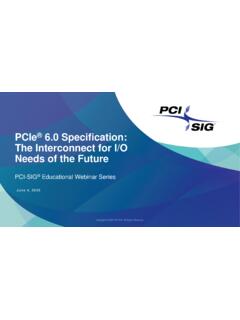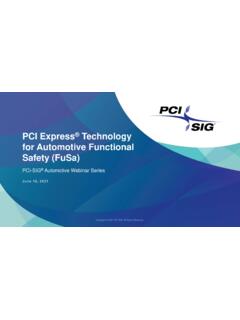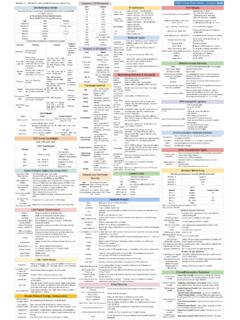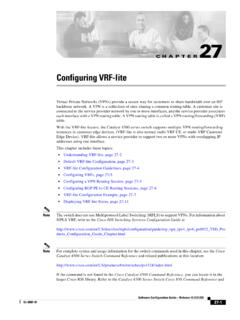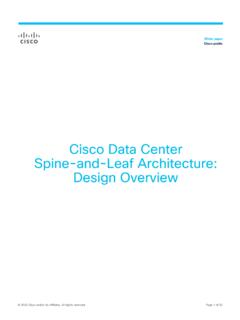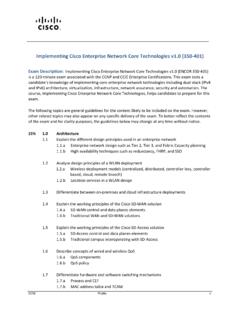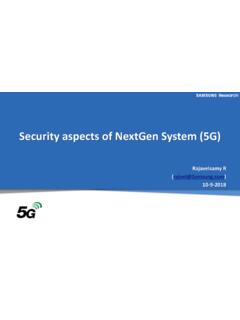Transcription of PCI Express Basics & Background
1 Copyright 2014, PCI-SIG, All Rights Reserved1 PCI Express Basics & BackgroundRichard SolomonSynopsysPCIeTechnology Seminar2 AcknowledgementsThanks are due to Ravi Budruk, Mindshare, Inc. for much of the material on PCI Express Basics2 Copyright 2014, PCI-SIG, All Rights ReservedPCIeTechnology SeminarAgenda PCI Express Background PCI Express Basics PCI Express Recent DevelopmentsCopyright 2014, PCI-SIG, All Rights Reserved3 PCIeTechnology Seminar4 PCI Express BackgroundCopyright 2014, PCI-SIG, All Rights ReservedPCIeTechnology SeminarCopyright 2014, PCI-SIG, All Rights Reserved5 Revolutionary AND Evolutionary PCI (1992/1993) Revolutionary Plug and Play jumperlessconfiguration (BARs)
2 Unprecedented bandwidth 32-bit / 33 MHz 133MB/sec 64-bit / 66 MHz 533MB/sec Designed from day 1 for bus-mastering adapters Evolutionary System BIOS maps devices then operating systems boot and run without further knowledge of PCI PCI-aware O/S could gain improved functionality PCI (1995) doubled bandwidth with 66 MHz modePCIeTechnology SeminarCopyright 2014, PCI-SIG, All Rights Reserved6 Revolutionary AND Evolutionary PCI-X (1999) Revolutionary Unprecedented bandwidth Up to 1066MB/sec with 64-bit / 133 MHz Registered bus protocol Eased electrical timing requirements Brought split transactions into PCI world Evolutionary PCI compatible at hardware *AND* software levels PCI-X (2003) doubled bandwidth 2133MB/sec at PCI-X 266 and 4266MB/sec at PCI-X 533 PCIeTechnology SeminarCopyright 2014, PCI-SIG, All Rights Reserved7 Revolutionary AND Evolutionary PCI Express aka PCIe (2002) Revolutionary Unprecedented bandwidth x1: up to 1GB/sec in *EACH* direction x16.
3 Up to 16GB/sec in *EACH* direction Relaxed electricalsdue to serial bus architecture Point-to-point, low voltage, dual simplex with embedded clocking Evolutionary PCI compatible at software level Configuration space, Power Management, etc. Of course, PCIe-aware O/S can get more functionality Transaction layer familiar to PCI/PCI-X designers System topology matches PCI/PCI-X (2006) doubled per-lane bandwidth: 250MB/s to 500MB/s (2010) doubled again to 1GB/ will double again to 2GB/s/lane!PCIeTechnology SeminarCopyright 2014, PCI-SIG, All Rights Reserved8 PCI ConceptsPCIeTechnology SeminarCopyright 2014, PCI-SIG, All Rights Reserved9 Address Spaces Memory & I/O Memory space mapped cleanly to CPU semantics 32-bits of address space initially 64-bits introduced via Dual-Address Cycles (DAC)
4 Extra clock of address time on PCI/PCI-X 4 DWORD header in PCI Express Burstable I/O space mapped cleanly to CPU semantics 32-bits of address space Actually much larger than CPUs of the time Non-burstable Most PCI implementations didn t support PCI-X codified Carries forward to PCI ExpressPCIeTechnology SeminarCopyright 2014, PCI-SIG, All Rights Reserved10 Address Spaces Configuration Configuration space??? Allows control of devices address decodes without conflict No conceptual mapping to CPU address space Memory- based access mechanisms in PCI-X and PCIe Bus / Device / Function (aka BDF) form hierarchy- based address (PCIe calls this routing ID ) Functions allow multiple, logically independent agents in one physical device combination SCSI + Ethernet device 256 bytes or 4K bytes of configuration space per device PCI/PCI-X bridges form hierarchy PCIe switches form hierarchy Look like PCI-PCI bridges to software Type 0 and Type 1 configuration cycles Type 0: to same bus segment Type 1.
5 To another bus segmentPCIeTechnology SeminarCopyright 2014, PCI-SIG, All Rights Reserved11 Configuration Space (cont d)ProcessorProcessorProcessorProcessorHo st/PCI BridgeBus = 0 Subord = 3 Host/PCI BridgeBus = 4 Subord = 5 MainMemoryPCI Bus 0 PCI Bus 1 PCI Bus 2 PCI Bus 4 PCI Bus 5 PCI-to-PCIB ridgePrimary = 0 Secondary = 1 Subord = 3 PCI-to-PCIB ridgePrimary = 4 Secondary = 5 Subord = 5 PCI-to-PCIB ridgePrimary = 1 Secondary = 2 Subord = 2 PCI Bus 3 PCI-to-PCIB ridgePrimary = 1 Secondary = 3 Subord = 3 Address PortData PortAddress PortData PortPCIeTechnology SeminarCopyright 2014, PCI-SIG, All Rights Reserved12 Configuration Space Device Identification VendorID: PCI-SIG assigned DeviceID: Vendor self-assigned Subsystem VendorID.
6 PCI-SIG Subsystem DeviceID: Vendor Address Decode controls Software reads/writes BARs to determine required size and maps appropriately Memory, I/O, and bus-master enables Other bus-oriented controlsPCIeTechnology SeminarCopyright 2014, PCI-SIG, All Rights Reserved13 Configuration Space Capabilities List Linked list Follow the list! Cannot assume fixed location of any given feature in any given device Features defined in their related specs: PCI-X PCIe PCI Power Management Etc. Capability IDPointer toNext CapabilityFeature-specificConfiguration Registers078153116 Dword nDword 1 Dword 0 PCIeTechnology SeminarCopyright 2014, PCI-SIG, All Rights Reserved14 Configuration Space Extended Capabilities List PCI Express only Linked list Follow the list!
7 Cannot assume fixed location of any given feature in any given device First entry in list is *always* at 100h Features defined in PCI Express specificationCapability IDPointer to Next CapabilityFeature-specific Configuration Registers078153116 Dword nDword 1 Dword 01920 VersionPCIeTechnology SeminarCopyright 2014, PCI-SIG, All Rights Reserved15 Interrupts PCI introduced INTA#, INTB#, INTC#, INTD# -collectively referred to as INTx Level sensitive Decoupled device from CPU interrupt System controlled INTx to CPU interrupt mapping Configuration registers report A/B/C/D programmed with CPU interrupt number PCI Express mimics this via virtual wire messages Assert_INTx and Deassert_INTxPCIeTechnology SeminarCopyright 2014, PCI-SIG, All Rights Reserved16 What are MSI and MSI-X?
8 Memory Write replaces previous interrupt semantics PCI and PCI-X devices stop asserting INTA/B/C/D and PCI Express devices stop sending Assert_INTx messages once MSI or MSI-X mode is enabled MSI uses one address with a variable data value indicating which vector is asserting MSI-X uses a table of independent address and data pairs for each vector NOTE: Boot devicesand any device intended for a non-MSI operating system generally must still support the appropriate INTx signaling!PCIeTechnology SeminarCopyright 2014, PCI-SIG, All Rights Reserved17 Split Transactions Background PCI commands contained no length Bus allowed disconnects and retries Difficult data management for target device Writes overflow buffers Reads require pre-fetch How much to pre-fetch?
9 When to discard? Prevent stale data? PCI commands contained no initiator information No way for target device to begin communication with the initiator Peer-to-peer requires knowledge of system-assigned addressesPCIeTechnology SeminarCopyright 2014, PCI-SIG, All Rights Reserved18 Split Transactions PCI-X commands added length and routing ID of initiator Writes: allow target device to allocate buffers Reads: Pre-fetch now deterministic PCI-X retains retry & disconnect , adds split Telephone analogy Retry: I m busy go away Delayed transactions are complicated Split: I ll call you back Simple More efficientPCIeTechnology SeminarCopyright 2014, PCI-SIG.
10 All Rights Reserved19 Benefits of Split Transactions2550100125150175200225250275 Number of Load Exerciser Cards12345 Bandwidth MegaBytes/sec50%60%70%80%90%100%10%20%30 %40%Percent of Total Bandwidth2550100125150175200225250275 Number of Load Exerciser Cards2150%60%70%80%90%100%10%20%30%40%Pe rcent of Total BandWidthSystem Overhead--SchedulingTransaction Overhead --Addressing and RoutingTransaction Data Payload --Actual user dataIdle Time--Unused BWTransactionData Payload--Actual userdataIdle Time--Unused BWSystem Overhead--SchedulingTransaction Overhead --Addressing and RoutingBandwidth MegaBytes/secBandwidth Usage with Conventional PCI ProtocolsBandwidth Usage with PCI-X EnhancementsPCIeTechnology SeminarCopyright 2014, PCI-SIG, All Rights Reserved20 PCI Express BasicsPCIeTechnology SeminarCopyright 2014, PCI-SIG, All Rights Reserved21 PCI Express Features Dual Simplex point-to-point serial connection Independent transmit and receive sides Scalable Link Widths x1, x2, x4, x8, x12, x16, x32 Scalable Link Speeds , and (16GT/s coming in ) Packet based transaction protocolPCIeDeviceAPCIeDeviceBLink (x1, x2, x4, x8, x12, x16 or x32)




